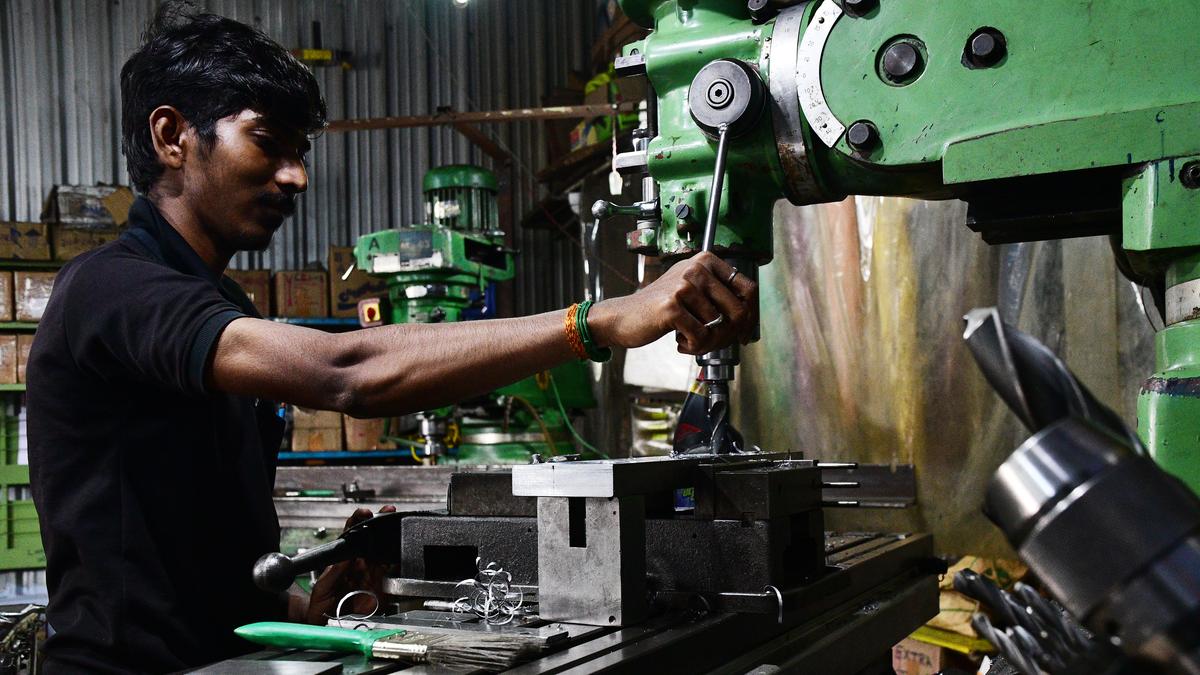In recent decades, India’s formal manufacturing sector has witnessed a significant negative change in its employment structure. According to the Annual Surveys of Industries (ASI), the share of contract labour in the manufacturing workforce doubled from 20% in 1999-2000 to 40.7% in 2022-23, cutting across all industries. The growing trend towards informalisation within the formal sector has been widely written about in academic and policy circles. Our study, based on plant-level ASI longitudinal data (1999-2000 to 2018-19) at an all-India level, reveals that contractualisation is detrimental to productivity when misused, highlighting the need to promote formalisation to sustain long-term productivity growth.
Plight of contract workers
The shift towards contractualisation is often viewed as a strategy to enhance operational flexibility and access specialised skills as and when required. However, examination of the plight of contract workers suggests that cost avoidance, rather than genuine labour flexibility or skills, is a major factor driving their growing use. Contract workers, typically hired through third-party contractors, are excluded from core labour laws under the Industrial Disputes Act 1947, which governs layoffs, retrenchments, and safeguards against arbitrary dismissals. Consequently, their bargaining power remains weak, leaving them vulnerable to exploitation.
The wage payments of contract workers in 2018-19 were 14.47% lower than their regular counterparts. The unfavourable wage differentials against them were more pronounced in large enterprises (31%), followed by medium and small enterprises (23% and 12%, respectively). Furthermore, if we consider the difference in the overall labour cost for employers on contract and regular workers, the disparities look even starker. The average daily labour cost to the employer for contract workers was 24% lower when compared to regular workers. The labour costs on contract workers were less than 50% of that on regular workers, in at least nine three-digit level industries. In some industries, labour-cost gaps were as high as 78% to 85%, reflecting the severe level of exploitation that contract workers face.
Impact on productivity
Undoubtedly, contract workers can bring job-specific skills and serve as a buffer, enabling firms to respond swiftly to market fluctuations. However, contractual employment, particularly when mediated through third-party contractors for the short term, can suffer from principal-agent problem, i.e., the misalignment of long-term interests between employers and contractors. This can lead to moral hazard issues, such as an increased likelihood of worker shirking. Moreover, short-term employment contracts can create instability in the workforce due to high labour turnover, discouraging investments in on-the-job training and innovation, stifling productivity growth in the long run.
Our analysis of real net value added per worker, a standard measure of labour productivity, shows that contract labour-intensive (CLI) enterprises have, on an average, 31% lower labour productivity when compared to regular labour-intensive (RLI) enterprises. The labour productivity gap remains higher especially in small formal enterprises with less than 100 workers (36%), followed by medium-sized enterprises with 100-300 workers (23%). The unfavourable productivity gap for CLI enterprises further widens to 42% in labour-intensive enterprises. These differentials remain significant even after controlling for firm-specific and state-specific factors that could influence labour productivity.
The negative productivity differentials observed in relatively small, medium, and labour-intensive CLI enterprises may be attributed to their higher propensity to employ contract labour as a cost-cutting measure or as a means to circumvent regulations. These are practices that ultimately prove counterproductive in the long run.
However, labour productivity was 5% higher in high-skill CLI enterprises when compared to their low-skill counterparts, with the productivity advantage increasing significantly to 20% in large high-skill CLI enterprises. Similarly, large-size capital-intensive CLI enterprises recorded a 17% gain in labour productivity. However, such types of enterprises account for only about 20% of the total formal manufacturing. The remaining 80% of the enterprises were adversely affected by contractualisation.
Policy suggestions
The central government, in 2020, introduced a labour code on industrial relations, which aims to provide greater flexibility in hiring and firing. The code allows firms to hire non-regular workers on fixed-term contracts directly without third party contractors, though it also seeks to curb the exploitation of non-permanent workers by mandating the provision of basic statutory employment benefits. However, as the labour code awaits implementation, labour unions warn that the increased flexibility in hiring non-regular workers could accelerate informalisation and further erode quality of jobs in the formal sector.
Policymakers can incentivise firms to adopt reasonably longer fixed-term contracts by offering concessions in social security contributions or subsidised access to government skilling programmes. This could enhance workforce stability and support skill accumulation, while also assuaging labour union fears about the potential rise in the precarious employment.
Similarly, the Central government in 2016 implemented the Pradhan Mantri Rojgar Protsahan Yojana (PMRPY) to incentivise job creation in the formal sector by bearing employer’s contribution (12%) to Employees’ Pension Scheme (EPS) and Employees’ Provident Fund (EPF). Though over one crore employees benefited from the scheme, it was discontinued in March 2022. Reviving and extending support under the PMRPY could help curb the misuse of contract labour and promote formalisation in the manufacturing sector.
Irfan Ahmad Sofi is In-charge Head, Department of Economics, Islamic University of Science & Technology, Kashmir
Published – July 30, 2025 12:10 am IST
